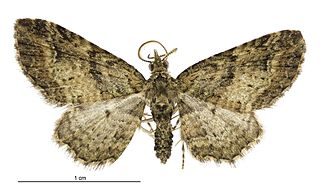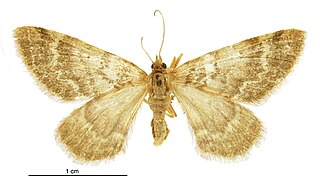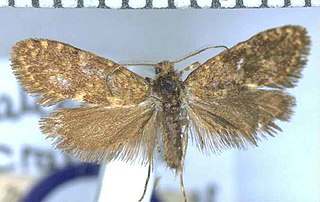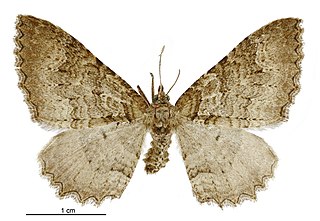
Ichneutica is a genus of cutworm or dart moths in the family Noctuidae. The genus is found in New Zealand and surrounding islands. There are more than 80 described species in Ichneutica, the largest known genus of Lepidoptera in New Zealand. In 2019 this genus was revised and greatly expanded with the genera Graphania Hampson, 1905, Tmetolophota Hampson, 1905 and Dipaustica Meyrick, 1912 all subsumed within it.

Asaphodes is a genus of moths in the family Geometridae erected by Edward Meyrick in 1885. This genus is endemic to New Zealand and species within this genus are found throughout New Zealand including the North, South and Stewart / Rakiura Islands.

Dasyuris is a genus of moths in the family Geometridae first described by Achille Guenée in 1868.

Archyala is a genus of moths belonging to the family Tineidae. This genus is endemic to New Zealand. Archyala was first described by Edward Meyrick in 1889.

Austrocidaria parora is a species of moth of the family Geometridae. It is endemic to New Zealand.

Xanthorhoini is a tribe of geometer moths under subfamily Larentiinae. The tribe was described by Pierce in 1914.

Asterivora is a genus of moths in the family Choreutidae. Asterivora was described by J. S. Dugdale in 1979. The type species is Asterivora combinatana.

Izatha is a genus of moths of the family Oecophoridae. They are commonly known as lichen tuft moths. This genus is endemic to New Zealand.

Amblyptilia epotis is a moth of the family Pterophoridae. It is endemic to New Zealand and is found in the South and Stewart Islands. It inhabits mountainous terrain covered in alpine vegetation or alternatively alpine wetland habitat. The adults of this species are on the wing from February to March. In appearance the adults of this species are variable in colour however this species can be distinguished from similar species by the oblique apical streak on its forewings as well as the patch of white on the costa cilia towards the apex of the forewing.

Pasiphila charybdis is a species of moth in the family Geometridae. It is endemic to New Zealand.

Heterocrossa is a genus of moths in the Carposinidae family. It is endemic to New Zealand. This genus was previously regarded as a synonym of the genus Carposina. However Elwood C. Zimmerman in Insects of Hawaii removed Heterocrossa from synonymy with Carposina. Zimmerman argued that as the genitalia of Heterocrossa and Carposina are distinct, Heterocrossa should not be regarded as a synonym of Carposina. This was agreed with by John S. Dugdale in his annotated catalogue of New Zealand Lepidoptera.

Hierodoris is a genus of moths in the family Oecophoridae. It was first described by Edward Meyrick in 1912. This genus is only known from New Zealand. In 1988 the genus Taoscelis was synonymised with Hierodoris. In 2005 the genus Coridomorpha was synonymised with Hierodoris.

Asaphodes aphelias is a species of moth in the family Geometridae. It is endemic to New Zealand and has been observed in Fiordland. This species inhabits damp native scrub and has been observed in upland wetlands at altitudes of between 800 and 1100 m. Adults are on the wing in February but the female of this species is unusual as it has narrow fore and hind wings.

Austrocidaria lithurga is a species of moth in the family Geometridae. It is endemic to New Zealand. This moth is classified as at risk, naturally uncommon by the Department of Conservation.

Tingena is a genus of the concealer moth family (Oecophoridae). This genus is endemic to New Zealand.

Austrocidaria prionota is a species of moth in the family Geometridae. It is endemic to New Zealand. It is found in the South Island and regarded as being uncommon.

Mallobathra is a genus of moths belonging to the family Psychidae, and are bagworm moths. This genus was first described by Edward Meyrick. It is endemic to New Zealand. The type species of this genus is Mallobathra crataea.

Austrocidaria callichlora is a species of moth of the family Geometridae. It endemic to New Zealand. It was first described by Arthur Gardiner Butler in 1879 and named Cidaria callichlora.

Austrocidaria cedrinodes is a species of moth of the family Geometridae. It endemic to New Zealand.



















